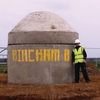Simulators | New build
Field test
7 December 2011A new UK training programme aims to give engineering students practical experience on a nuclear construction site and increase awareness of nuclear safety culture.
This summer, a 25-strong team of engineering students from Imperial College London spent a week on a real construction site, building a 1/10th scale containment building and installing a 0.6-tonne reactor pressure vessel for a mock nuclear power plant.
The programme, Nuclear Island, consists of a triangle formed by a university, contractor and consultant working in partnership. Imperial was involved in the project with contractor John Doyle and consultant Expedition Engineering. The project ran from 15 to 22 June 2011.
Mark Wenman, the Imperial nuclear engineering lecturer who helped lead the pilot project, says: “It’s quite a basic project in terms of construction, but we wanted students to focus on the quality of the build. Getting the students to understand that in a nuclear build quality means safety was a key message.”
At the beginning of the project the engineering students were briefed on the construction of Bircham B, a fictitious nuclear reactor to be built on a fictitious existing nuclear licensed site. Students were given construction and engineering plans for a scaled-down containment structure.
Technicians were available to help the students build the formwork for the concrete and crane drivers and excavators were at their disposal. A site manager from John Doyle was responsible for ensuring safety on the construction site.
Three MSc nuclear engineering students from Imperial took on the role of the energy company/operator and were responsible for overseeing construction work. Second-year civil engineering students acted as the contractor and carried out the construction (with the help of John Doyle). Apprentices from a construction college were also involved in the project, along with staff from Imperial and a mock regulator played by Clive Smith, skills director for nuclear at the UK?government’s Cogent Sector Skills Council, a partner in the project.
Students built a concrete cylindrical containment structure (about 2.5 m wide by 2.5 m tall) with a reinforced steel dome. They also installed a real reactor pressure vessel, which they pressurized to around 16 bar.
In addition to the construction, students took part in a mock public consultation where they took on roles as either engineers on the project or concerned members of the public. Students also had to keep the project on budget; they negotiated a price with the customer and had to ensure that the project costs were met.
At the end the week the structure was tested with an impact of a 150 kg weight; no damage was observed.
Photo timeline:







Learning outcomes
The Nuclear Island programme introduced civil engineering students to nuclear behaviours and safety culture.
For example, Nuclear Island was the only one of five construction projects underway at the National Construction College’s Bircham Newton, Norfolk communal training site to be surrounded by a fence. Entry into the site had to be closely monitored, as if a real reactor was under construction on the site.
Oliver Broadbent director of Think Up, the educational arm of Expedition Engineering, which helped design the pilot project, explains that there was a high focus on quality during the build.
“We built in requirements that meant students needed to design quality control systems,” says Broadbent. “We developed a concrete checklist based on real lists that they would use at construction site. “Students needed to carry out slump tests to make sure the concrete was the right type and consistency and ensure that it was poured in the correct way.”
Wenman added: “Students need to understand that any design changes impact the safety cases.” He explained how the students had to drill a hole in the dome of the reactor building to install it. The significance of modifications to the safety case was highlighted.
In addition to safety lessons, the students also gained practical experience. “Students could learn more in one week than in a year of lectures,” says Wenman.
For example, Wenman says that the students forgot to include the striking piece when they put down the formwork for the base slab. This made the removal of the formwork very difficult once the concrete had set. This was a lesson that the students had to learn the hard way during the build. It also highlighted how construction quality issues can affect many future aspects of the project, from the safety case to the cost.
“These are the people that could be involved in building these plants in future. We need to get the awareness into civil engineering companies,” Wenman says.
What next?
Wenman says that Imperial is currently gathering together feedback from the pilot project. The next stage is to refine the Nuclear Island programme with other academic partners, including the universities of Birmingham, Manchester, Leeds, Glyndwr (in Wrexham) and Bridgewater College in Somerset. A model (based on the pilot project) will be designed for these partners to use in spring 2012, before dissemination to other academic institutions in future, according to Cogent. Possible expansions to the Nuclear Island programme in future could include pipework (mechanical engineering) and electrics (electrical engineering), he says.
There have also been requests from industry to expand the programme to incorporate apprentices and graduate/professional training. Cogent says that the task now is to identify the right funding model and partners.
Cogent was a partner in the project along with Imperial College London, the Engineering Construction Industry Training Board (ECITB), Construction Skills and the National Construction College’s hands-on training programme, Constructionarium. The UK government HE-STEM programme and the Royal Academy of Engineering funded the project.
Author Info:
This article was originally published in the November 2011 issue of Nuclear Engineering International magazine.










